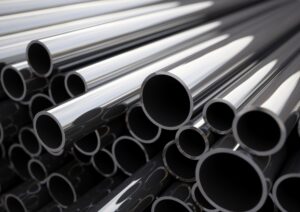
The advantages of stainless steel make it a premier material choice for many projects. Thanks to its corrosion resistance, fire and heat resistance, hygiene, aesthetic appeal, strength-to-weight advantage, ease of fabrication, and impact resistance, stainless steel tubing has been widely used across industries for decades. It is the go-to solution when reliability and versatility are key. Additionally, stainless steel has impressive longevity when properly cared for and maintained, making it the cost-effective choice in the long run. With such a wide range of advantages, it is no surprise why stainless steel remains a popular material choice for many applications.
1. Strength
Stainless steel is renowned for its incredible strength thanks to its unique composition of iron, chromium, and other alloys. This composition makes stainless steel up to five times stronger than regular steel. It has a higher tensile strength than carbon steel and high-performance plastics, rendering it highly resistant to deformation, bending, and breakage.
Compared to plastics, stainless steel offers higher strength and durability. Plastics may not withstand high levels of pulling or stretching without deformation. Some plastics can be brittle, especially at low temperatures, making them susceptible to cracking or breaking under impact or stress. Stainless steel is essential for meeting demanding engineering challenges and providing a long-lasting, reliable solution.
Stainless steel also maintains its strength at high temperatures, so it is often used in applications such as aircraft engines and power plants. This superior strength allows stainless steel to handle heavy loads and stress, making it the ideal material for heavy-duty equipment and machinery.
2. Corrosion Resistance
Corrosion resistance is one of stainless steel’s most significant and valuable properties. Unlike other materials prone to rust and other forms of corrosion when exposed to moisture and harsh chemicals, stainless steel stays pristine and unscathed. This is because the addition of chromium in stainless steel forms a barrier that prevents rust and other forms of corrosion from occurring.
Chromium is the alloying element that imparts the corrosion resistance qualities to stainless steel. The chromium forms a thin, invisible, and self-repairing layer on the steel surface, known as the passive layer. This passive layer is a protective barrier, preventing the underlying steel from exposure to corrosive agents such as moisture, oxygen, and chemicals.
This property makes stainless steel ideal for equipment and machinery that come into contact with saltwater, acids, and other corrosive materials. It is also ideal for medical implants and instruments that must withstand exposure to bodily fluids and cleaning agents.
A common alternative, carbon steel, offers limited corrosion resistance, making it unsuitable for highly corrosive or acidic applications, where it may degrade rapidly. As for high-performance plastics, they can have chemical sensitivity. Despite their enhanced properties, they can still be susceptible to chemical attacks and degradation when exposed to aggressive chemicals and solvents. Also, environmental factors such as exposure to UV radiation, moisture, and high temperatures contribute to the degradation process of plastics. Stainless steel’s ability to withstand corrosion and degradation over time makes it a durable and more reliable material choice. Its ability to maintain structural integrity and appearance over time ensures a consistent and low-maintenance solution for critical engineering projects.
3. Low Maintenance
Stainless steel is known for its low maintenance requirements, making it a cost-effective material in the long run. Its resistance to corrosion means it does not require any coatings or special treatments to prevent damage. It is also easy to clean using simple soap and water, unlike other materials requiring harsher cleaning agents. Stainless steel’s low maintenance property makes it an ideal material for applications where downtime for maintenance would damage productivity.
4. Versatility
Stainless steel is a versatile material that can be cast, forged, machined, and welded into various shapes and sizes. It can also be finished in various ways, such as brushed, polished, or matte. This versatility makes stainless steel popular in many industries where aesthetics and design are important, such as the medical and architectural sectors. This flexibility also seamlessly integrates stainless steel components into existing equipment and machinery.
5. Cost-Effective
Although stainless steel may have a higher initial cost than other materials, its longevity, low maintenance requirements, and corrosion resistance make it a cost-effective choice in the long run. Stainless steel is also recyclable, making it an environmentally friendly choice that saves on disposal costs in the long run.
Contact the Experts at Eagle Stainless
Stainless steel is a superior material with unmatched strength, durability, and corrosion resistance, making it the go-to choice in many industries. Its low maintenance requirements, versatility, and cost-effectiveness make it an ideal material for heavy-duty equipment, machinery, and medical implants. As a versatile material that can be machined and finished in various ways, stainless steel is an excellent choice for applications where aesthetics and design are important. Whether you are in the medical, industrial, or aerospace industry, stainless steel is a reliable material that offers unparalleled advantages.
As an experienced stainless steel tubing supplier and fabricator, Eagle Stainless can offer guidance for standard and custom stainless steel options, whatever your application may be. Contact us today to learn more.



